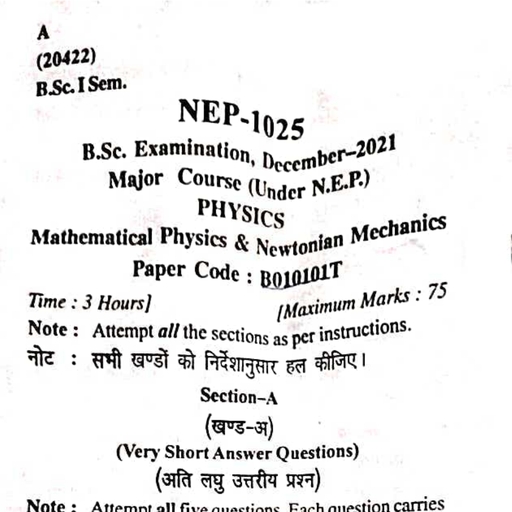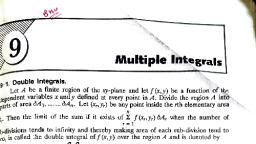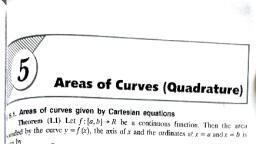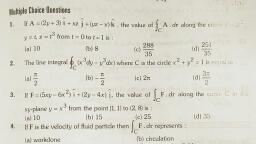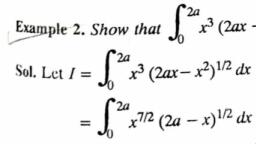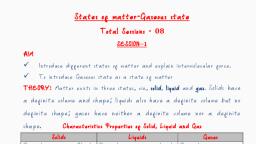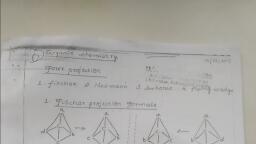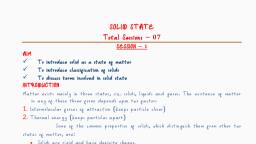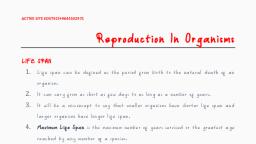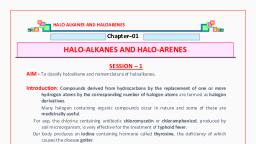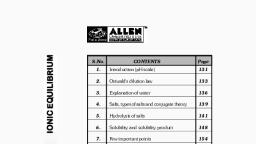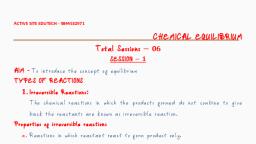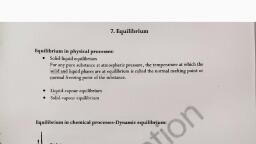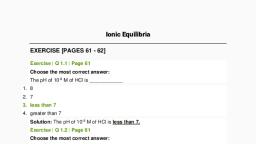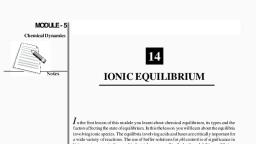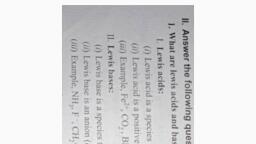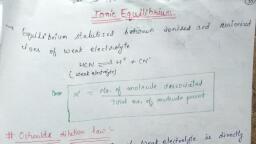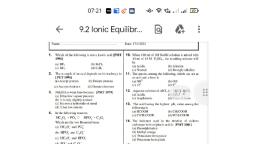Page 1 :
ACTIVE SITE EDUTECH - 9844532971, , IONIC EQUILIBRIUM, Total Sessions – 11, SESSION – 1, AIM - To introduce the Concept of Acids and Bases, THEORY, In chemical equilibrium we studied reaction involving molecules only but in ionic, equilibrium we will study reversible reactions involving formation of ions in water., When solute is polar covalent compound then it reacts with water to form ions., Electrical conductors, Substances, which allow electric current to pass through them, are known as, conductors or electrical conductors., Conductors can be divided into two types,, (1) Conductors which conduct electricity without undergoing any chemical, change are known as metallic or electronic conductors., Conductors which undergo decomposition (a chemical change) when an, electric current is passed through them are known as electrolytic conductors or, electrolytes., (2), , Electrolytes, divided into two types on the basis of their strengths,, (i) Substances which almost completely ionize into ions in their aqueous solution, are called strong electrolytes., Degree of ionization for this type of electrolyte is one i.e.,, For example : HCl, H2SO4, NaCl, HNO3 , KOH, NaOH,, strong acids, bases and all types of salts., , HNO3 , AgNO3 , CuSO4, , α ≈ 1., , etc. means all, , (ii) Substances which ionize to a small extent in their aqueous solution are, known as weak electrolytes.
Page 2 :
Active site edutech-9844532971, , Degree of ionization for this type of electrolytes is, , α <<< 1., , For example: H2O, CH3COOH, NH4OH, HCN, Liq. SO2 , HCOOH etc. means all, weak acids and bases., Different concepts have been put forth by different investigators to, characterize acids and bases but the following are the three important modern, concepts of acids and bases:, 1. Arrhenius concept:, According to Arrhenius concept, all substances which give H+ ions when, dissolved in water are called acids while those which ionize in water to, furnish OH- ions are called bases., HA ⇌ H + + A− (Acid), BOH ⇌ B + + OH − (Base), , Thus, HCl is an acid because it gives H+ ions in water., Similarly, NaOH is a base as it yields OH− ions in water., HCl ⇌ H + + Cl−, NaOH ⇌ Na+ + OH −, , • Some acids and bases ionize almost completely in solutions and are called, strong acids and bases., Exp- HCl, HNO3 , H2 SO4 , HClO4 ,etc., are strong acids, , NaOH, KOH,, , Ba(OH)2 are strong bases., , • Others are dissociated to a limited extent in solutions and are termed weak, acids and bases., Note- Every hydrogen compound cannot be regarded as an acid,, e.g., CH4 is not an acid. Similarly, CH3 OH, C2 H5 OH , etc., have OH, groups but they are not bases.
Page 3 :
Active site edutech-9844532971, , Actually, free H + ions do not exist in water. They combine with solvent, molecules/ i.e., have strong tendency to get hydrated., HX + H2 O ⇌ H3 O+ + X −, , The reaction between an acid and a base is termed neutralization., According to Arrhenius, concept, the neutralization in aqueous solution, involves the reaction between H + and OH − ions or hydronium and OH− ions., This can be represented as, H3 O+ + OH − ⇌ 2H2 O, , Limitations:, • The concept does not explain acidic and basic character of substances in, non-aqueous solvents., • It could not explain the basic nature of, nature of non-metal oxides., , NH3, , and metallic oxides and acidic, , • It could not explain the behaviour of acids/bases in non aqueous solutions., • It could not explain the neutralization reaction giving salt in absence of a, solvent., • It could not explain the acid character of certain salts like AlCl3, BF3, etc. in aqueous solution., • It could not explain the existence of H+ in water., 2. Bronsted-Lowry concept:, According to Bronsted-Lowry concept an acid is a substance (molecule or, ion) that can donate proton, i.e., a hydrogen ion H+ , to some other, substance., A base is substance that can accept a proton from an acid., More simply, an acid is a proton-donor and a base is a proton acceptor.
Page 4 :
Active site edutech-9844532971, , Consider the reaction,, HCl + H2 O ⇌ H3 O+ + Cl−, , Here, HCl acts as an acid because it donates a proton to the water, molecules/Water, on the other hand, behaves as a base by accepting a, proton from the acid., The dissolution of ammonia in water may be represented as, NH3 + H2 O ⇌ NH4+ + OH −, , In this reaction, H2 O acts as an acid as it donates a proton to, molecules and NH3 molecule behaves as a base as it accepts a proton., , NH3, , • When an acid loses a proton, the residual part of it has a tendency, to regain a proton. Therefore, it behaves as a base., 𝐀𝐜𝐢𝐝 ⇌ 𝐇 + + 𝐛𝐚𝐬𝐞, , Acid and base which differ by a proton are known to form a conjugate pair., Consider the following reaction:, CH3 COOH + H2 O ⇌ H3 O+ + CH2 COO−, , It involves two conjugate pairs. The acid-base pairs are, CH3 COOH, Acid, , −H +, , ⇌ CH3 COO−, , +H +, , Base, , +H +, , H2O ⇌ H3O+, +, , Base, Acid, and, Such pairs of substances which can be formed from one another by loss or, gain of a proton are known as conjugate acid-base pairs., If in the above reaction, the acid CH3 COOH is labeled acid1 and its, conjugate base, CH3 COO− as base1. H2 O is labeled as base2 and its, conjugate acid H3 O+ as acid2, the reaction can be written as, −H, , Acid1 + Base2 ⇌ Base1 + Acid2
Page 7 :
Active site edutech-9844532971, , solvents. On the basis of proton interaction, solvents can be classified into, four types., i. Protophilic solvents: Solvents which have greater tendency to accept protons,, i.e., water, alcohol. Liquid ammonia, etc., ii. Protogenic solvents: Solvents which have the tendency to produce protons,, i.e., water, liquid hydrogen chloride, glacial acetic acid, etc., iii. Amphiprotic solvents: Solvents which act both as protophilic or protogenic,, e.g., water, ammonia, ethyl alcohol, etc., iv. protic solvents: Solvents which neither donate nor accept protons, e.g.,, benzene, carbon terachloride, carbon disulphide, etc., Limitations, * Failed to explain the acidic nature of BF3, * Failed to explain the basic nature of MgO, Cao etc, 3. Lewis concept:- According to this concept, a base is defined as a substance, which can furnish a pair of electrons to form a coordinate bond whereas an, acid is a substance which can accept a pair of electrons., The acid is also known as electron pair acceptor or electrophile while, the base is electron pair donor or nucleophile., H3 N •• + BF3 = H3N → BF3, Base, Acid, H + + •• NH3 = [H ← NH3 ]+, Acid, Base, BF3 + [F]− = [F → BF3 ]+, Acid Base, , Lewis concept is more general than the Bronsted Lowry concept.
Page 8 :
Active site edutech-9844532971, , According to Lewis concept, the following species can act as Lewis acids:, • Molecules in which the central atom has incomplete octet: All compounds, having central atom with less than 8-electrons are Lewis acids, e.g., BF3 , BCl3 , AlCl3 , BeCl2, etc., • Simple cations: All cations are expected to act as Lewis acids since they, are deficient in electrons. However, cations such as Na+ , K + , Ca2+ , etc, have, a very little tendency to accept electrons,while the cations like, H + , Ag + Fe2+ , CO2+ , Mn2+ etc., have greater tendency to accept electrons, and, therefore, act as Lewis acids., • Molecules in which the central atom has empty d-orbitals: The central atom, of the halides such as SiX4 , GeX4 , TiCl4 , SnX4 , PX3 , PF5 , SF4 , SeF4 , TeCl4 etc.,, have vacant d-orbitals. These can, therefore, accept an electron pair and, act as Lewis acids., • Molecules having a multiple bond between atoms of dissimilar electro, negativity: Typical examples of molecules falling in this class of Lewis acids, are CO2 , SO2 and SO2. Under the influence of attacking Lewis base, one πelectron pair will be shifted towards the more negative atom., or HCO−3, The following species can act as Lewis bases, • Neutralspecies having at least one lone pair of electrons:, Exp-ammonia, amines, alcohols, etc., act as Lewis bases because they contain, a pair of electrons. NH3 , RNH2 , R 2 NH, R 3 N, H2 O, ROH, ROR etc.,, • Negatively charged species or anions: For example, chloride, cyanide,, hydroxide ions, etc., act as Lewis bases. CN− , Cl− , Br − , I− , OH− etc.,
Page 9 :
Active site edutech-9844532971, , Note- It may be noted that all Bronsted bases are also Lewis bases but all, Bronsted acids are not Lewis acids., • Molecles containing multiple bonds between atoms of same electronegativity, Ex: CH2 = CH2, ----Limitation:, Since, the strength of the Lewis acids and base is found to depend on the, type of reaction, it is not possible to arrange them in any order of their, relative strength., , WHATS UP US FOR MORE NOTES AND TEST PAPERS-9844532971, Greetings from Active site edutech, Create your own brand with copyrights free materials., Don't go for old copy, Updated 2020 study material ENGLISH, HINDI, TAMIL MEDIUM with your branding., 1) Foundation 6 to 10 with ppts, 2) CBSE 6 to 12 study materia*, 3) 11 &12th NEET and JEE materials & test papers (soft copy, printed copy), Each topic contains, 1) Detailed theory (session wise), 2) 1000mcqs per chapter (student copy +review copy), 3) 3-chapter wise papers, 4) power point presentation*, 5) PCMB power point presentation, 6) 1.38lakh PCMB mcqs with solutions, 7) *KVPY* *NTSE* materials, 8) Android app &website* for online platform, 9) School and students’ accessories, 10) Education related software’s with Active serial* key, Text us for details and sample sets, https://wa.me/919844532971
Page 10 :
Active site edutech-9844532971, , SESSION–2, AIM- To introduce Ostwald Dilution Law, To introduce Ionic Product of Water, Ostwalds’s Dilution Law:, According to Arrhenius theory, the molecules of an electrolyte in solution are, constantly splitting up into ions and the ions are constantly reuniting to, form unionized molecules. Therefore, a dynamic equilibrium exists between the, ions and the unionized molecules of the electrolyte in solution. It was pointed, out by Ostwald that like chemical equilibrium, law of mass action can be, applied to such systems also., This law deals with the application of the law of mass action to the equilibrium, between the ions and unionized molecules in aqueous solutions of weak binary, electrolytes such as acetic acid, propionic acid, HCN, NH4OH, etc., Consider a dilute solution of a weak binary electrolyte AB containing, c moles in 1litre. At any given temperature, there will be equilibrium between, the unionized molecules of AB and the ions A+ and B−. Let ‘’ be the degree, of dissociation of AB at equilibrium., AB, A+ + B−, Initial conc., c, 0, 0, Conc. at. equilb. c(1−) c, c, Then according to the law of mass action, the equilibrium constant Keq will be given, by Keq =, , [A+ ] [B− ], [AB], , =, , cα × cα, c(1 − α), , =, , α2 c, 1 − α, , 𝛼2 𝑐, , This expression “Keq = 1 − 𝛼” is called Ostwald’s dilution law., Keq is called the dissociation (or ionization) constant of the weak electrolyte., 1, , If 1 mole is present in ‘V’ litres of solution, c = V . Keq =, another expression for Ostwald’s dilution law., , 𝛼2, 𝑉(1−𝛼), , . This is
Page 11 :
Active site edutech-9844532971, , has a very small value for a weak electrolyte and is therefore negligible in, comparison with unity., 1 − 1., , Keq = 2c, =√, , Keq, c, , α = √K eq × V, , This law is valid only for weak electrolytes that too in dilute solutions. It is, not applicable for strong electrolytes., Degree of Dissociation(): The fraction of the total electrolyte that undergoes, dissociation at equilibrium is known as degree of dissociation., , α=, , NO.of dissociated molecules, Total no.of molecules, , The variation of ‘’ of an electrolyte is governed by:, (i) Nature of solute: All ionic compounds i.e. strong electrolytes have 1 at, normal dilution. Most of the polar covalent compounds i.e. weak electrolytes, have << 1, (ii) Nature of Solvent: Higher the dielectric constant of a solvent more is, , its ionising power. Water is the most powerful ionising solvent as its, dielectric constant is highest., (iii) Dilution: The extent of dissociation of an electrolyte increases with dilution of, solution., 𝛂 ∝, , 𝟏, Con. of solution, , ∝, , 𝟏, wt. of solution, , ∝, , Dilution of solution, , ∝, , Amount of solvent, , (iv) Temperature: The extent of dissociation of an electrolyte also increases with, an increase in temperature., (v) Addition of other species with commom ion: Addition of another solute having, an ion common to that of weak electrolyte shows a decrease in degree of, dissociation of weak electrolyte.
Page 12 :
Active site edutech-9844532971, , i.e., The degree of ionisation of an electrolyte decreases in the, presence of a strong electrolyte having a common ion., 1., 2., , 3., , The smaller the value of Ka, the weaker the acid., The criteria for making approximation 1− 1 is decided by first solving, the problem by assuming 1−=1. After solving for , if a 5 percent or, 0.05, rework the problem using the quadratic formula., for strong electrolytes Ka approaches to infinity since approaches unity from, equation (1), , Comparison of strengths of acids and bases: According to the Ostwald’s dilution, K, , law, for a monobasic weak acid,α = √ Ca, Here α = Degree of ionization of the acid i.e. its proton (H+ ) releasing, tendency. Thus, if represents the strength of the acid, K a =Dissociation constant of the acid, C =Molar concentration of the acid solution,, For two acids, having the same molar concentration (C is constant), α1, α2, , Kα1, , = √K, , α2, , Strenght of the acid HA, , Kα1, , Or = Strenght of the acid HA1 = √K, 2, , α2, , Thus, the relative strengths of the two acids having same molar, concentration can be compared in terms of the square roots of their, dissociation (or ionization) constants., Similarly, for two bases having the same molar concentration (C is constant), Kα, Kb, α1, Strength of the base , (BOH)1, = √ 1 or, =√ 1, α2, K α2, Strength of the base , (BOH)2, K b2
Page 13 :
Active site edutech-9844532971, , Remember, K, , • For a weak electrolyte.[H+ ] = Cα = C × √ Cα = √K α . C, • Higher the K a value (or lesser the pK a value where pK a = − log Ka) for an, acid, stronger is the acid. Higher the K b value (or lesser the pK b value,, pK b = − log Kb ) for a base, stronger is the base., • For a dibasic acid like H2 SO4 , K a1 and K a2 represents the first and second, ionization constants., For tribasic acid like H3 PO4 , there are three ionization, constants.For such acids K a1 > K a2 > K a3, Similarly for polyacidic bases like Ca(OH)2 , K a1 > K a2, Ionic Product of water:, Pure water is a very weak electrolyte H2 O ⟶ H + + OH −, on applying the law of mass action at equilibrium,, Then, K =, , [H+ ][OH− ], [H 2 O], , or, , [H+ ][OH− ] = K[H2 O], , Since, ionization takes places to a very small extent, so the concentration, of unionized water molecule is regarded as constant. Thus the product of, K[H2O] gives another constant Kw., So, [H + ][OH− ] = K w, The product of concentration of H+ and OH- ion in water at a particular, temperature is known as ionic product of water., The value of K w increases with the increase in temperature i.e. the, ionization of water increases with increase in temperature and finally the, concentration of H + and OH − ions also increases., The values of K w at various temperature are given below:
Page 14 :
Active site edutech-9844532971, , Temperature (°𝐂), , Value of 𝐊 𝐰, , 1), , 0, , 0.11 × 10−14, , 2), 3), , 10, , 0.31 × 10−14, 1 × 10−14, , 4), , 60, , 2.9 × 10−14, , 5), 6), , 80, 100, , 5.6 × 10−14, 7.50 × 10−14, , 20 – 35 or 25° (Room temp. ), , The acidity and basicity depend upon the concentration of H+ and OH- ions., If, [H+ ] > [OH− ] = Acidic solution, [OH − ] > [H + ] = Basic solution, [OH − ] = [H + ] = Neutral solution, , When an acid or a base is added to water, the ionic concentration, product,[H+ ][OH− ]remains constant, i.e., equal to K w but concentrations of, H + and OH − ions do not remain equal. The addition of acid increases the, hydrogen ion concentration while that of hydroxyl ion concentration, decreases, i.e.,[H+ ] > [OH− ]; (Acidic solution), Similarly, when a base is added, the OH− ion concentration increases while, H + ion concentration decrease, i.e.,[OH − ] > [H + ]; (Alkaline or basic solution), In neutral solution, [H+ ] = [OH− ] = 1 × 10−7 M at 25°C, In acidic solution,[H+ ] > [OH− ], Or [H+ ] > 1 × 10−7 M, And [OH− ] < 1 × 10−7 M, In alkaline solution, [OH− ] > [H+ ], Or [OH− ] > 1 × 10−7 M, And [H+ ] < 1 × 107 M, Thus, if the hydrogen ion concentration is more than 1 × 10−7 M., the solution, will be acidic in nature and if less than 1 × 10−7 M , the solution will be, alkaline.
Page 15 :
Active site edutech-9844532971, , (Acidic), [H + ] = 10−7, (Neutral), [H + ] = 10 − 14 10−13 10−12 10−11 10−10 10−9 10−8, (Alkaline), We shall have the following table if OH−ion concentration is taken into account., [𝑂𝐻− ] = 10−14 10−13 10−12 10−13 10−10 10−9 10−8 (Acidic), [𝑂𝐻− ] = 10−7, (Neutral), [𝑂𝐻− ] = 10−0 10−1 10−2 10−3 10−4 10−5 10−6 (Alkaline), It is, thus, concluded that every aqueous solution, whether acidic, neutral or, alkaline contains both H− and OH− ions. The product of their concentrations, is always constant, equal to 1 × 10−14 at 25°𝐶 . If one increases, the other, decreases accordingly so that the product remains 1 × 10−14 at 25°𝐶., [H + ] = 10−0, , 10−1 10−2 10−3 10−4 10−5 10−6, , WHATS UP US FOR MORE NOTES AND TEST PAPERS-9844532971, Greetings from Active site edutech, Create your own brand with copyrights free materials., Don't go for old copy, Updated 2020 study material ENGLISH, HINDI, TAMIL MEDIUM with your branding., 1) Foundation 6 to 10 with ppts, 2) CBSE 6 to 12 study materia*, 3) 11 &12th NEET and JEE materials & test papers (soft copy, printed copy), Each topic contains, 1) Detailed theory (session wise), 2) 1000mcqs per chapter (student copy +review copy), 3) 3-chapter wise papers, 4) power point presentation*, 5) PCMB power point presentation, 6) 1.38lakh PCMB mcqs with solutions, 7) *KVPY* *NTSE* materials, 8) Android app &website* for online platform, 9) School and students’ accessories, 10) Education related software’s with Active serial* key, Text us for details and sample sets, https://wa.me/919844532971
Page 16 :
Active site edutech-9844532971, , SESSION – 3AND 4, AIM - To introduce pH scale, Hydrogen ion Concentration-PH Scale:, It is observed that when an acid or base is added to water, although the, ionic product, [H+][OH-], remains constant (equal to K w ),yet the, concentration of H3 O+ andOH− ion changes., In order to express the concentration of H3 O+ ion or H+ ions in, solution a new scale called pH scale was given by Sorensen., pH of a solution is defined as the negative logarithm of hydrogen ion (or, hydronium ion) concentration., pH = − log[H3 O+ ], Thus [H3 O+ ] = 10−pH mol L−1, , Similarly, negative logarithm of hydroxyl ion concentration is called, , pOH., , pOH = − log[OH − ], Also, K w = [H+ ][OH− ], −logK w = − log[H+ ] − log[OH− ], pK w = pH + POH, , For any acidic or basic solution, the sum of pH and pOH is equal to 14 and, is referred to as pKw at 298K. pH + pOH = pK w = 14, pH of a solution decreases with the increase in temperature, e.g. pH of, boiling water is 6.5625, although it is neutral., For neutral solution; pH = pOH = 7 at 298K., For acidic solution; pH < 7 But pOH > 7 at 298 K, For basic solution; pH > 7 But pOH < 7 at 298K
Page 17 :
Active site edutech-9844532971, , [H + ], , [OH − ], , pH, , pOH, , 10°, 10−2, 10−5, 10−7, 10−9, 10−11, 10−14, , 10−14, 10−12, 10−9, 10−7, 10−5, 10−3, 100, , 0, 2, 5, 7, 9, 11, 14, , 14, 12, 9, 7, 5, 3, 0, , Nature of solution, Strongly acidic, Acidic, Weakly acidic, Neutral, Weakly basic, Basic, Strongly basic, , Note: Decrease in conc. of [H+ ] by 10 times, pH increases by one unit., The following table shows the pH range for a few common substances:, S.NO, 1, 2, 3, 4, 5, 6, , Substance, Gastric Contents, Soft drinks, Lemons, Vinegar, Apples, Urine (human), , 𝒑𝑯range, 1.0 – 3.0, 2.0 – 4.0, 2.2 – 2.4, 2.4 – 3.4, 2.9 – 3.3, 4.8 – 8.4, , S.NO, 7, 8, 9, 10, 11, , Substance, Milk (cow), Saliva (human), Blood, plasma, (human), Milk of magnesia, Seawater, , pH range, 6.3 – 6.6, 6.5 – 7.5, 7.3 – 7.5, 10.5, 8.5, , Importance of 𝐩𝐇 value:, • pH has a great importance in agriculture. Soil is often tested to determine, whether acidic or basic fertilizers are required for a particular crop., • pHvalue plays important role in biological reactions such as digestion of food, etc, • Human blood has pH value of 7.36 – 7.42 A change in pH by 0.2units, results in death., • pH value plays an important role in qualitative analysis, • Food preservation also requires a definite pH value., Calculation of 𝐩𝐇 of Solutions: - Any method which can measure the concentration, of H+ ions or OH- ions in a solution can serve for finding pH value., 1. Normality of strong acid = [H3 O+ ], Normality of strong base = [OH − ], ∴ pH = − log[N] for strong acids, pOH = − log[N] for strong bases
Page 18 :
Active site edutech-9844532971, , 2. Sometimes, pH of acidto base becomes very close to that of 7. It shows that, the solution is very dilute; in such cases, H+ or OH− contribution from water is, also considered,, e.g., In 10−8N HCl, [H+ ]total = [10−8 ]acid + [10−7 ]water, = 11 × 10−8 M = 1.1 × 10−7 M, litre of an acidic solution of pH2, , 3. pH of mixture: Let one, litre of other acidic solution of pH 3. The resultant, be evaluated in the following way, , pH, , be mixed with two, of the mixture can, , Sample-1, Sample-2, pH = 2, pH = 3, +, −2, [H ] = 10 M, [H + ] = 10−3 M, V = 1 litre, V = 2 litre, M1 V1 + M2 V2 = MR (V1 + V2 ), 10−2 × 1 + 10−3 × 2 = MR (1 + 2), 12×10−3, , MR, 4 × 10−3 = MR (Here, MR = Resultant molarity), pH = − log(4 × 10−3 ), N V −N V, N = 1 1 2 2 is pH of mixture of acid base, 3, , V1 +V2, , N will give [H + ] or [OH − ]depending on equivalents of acid or base, 4. 𝐩𝐇, , of weak acids and weak bases:, Weak acids and bases are not completely ionized. An equilibrium is found to, have been established between the ions and unionised molecules., Let us consider a weak monobasic acid., , [H + ] = Cα; ∴ pH = − log10 [Cα], , Similarly, for weak base:, [OH − ] = Cα; ∴ pOH = log 10[Cα] and pH = 14 − pOH
Page 21 :
Active site edutech-9844532971, , pOH = − log(10−4 ) = 4, As pH + pOH = 14 So, pH + 4 = 14 or pH = 10, , c. H2 SO4 is a strong electrolyte and is ionized completely?, H2 SO4 ⇌ 2H + + SO2−, 4, , One molecule of H2 SO4 furnishes, So, [H+ ] = 2 × 10−4 M, , 2H + ions., , pH = − log[H + ], − log(2 × 10−4 ) = 3.70, , Example 2: Calculate the pH of the following solutions assuming complete, dissociation:, a] 0.365 gL−1 HCl solution, b] 0.0001 MBa(OH)2solution, Solution:, a. Mole mass of HCl = 36.5, Concentration of HCl = 0.365, = 1.0 × 10−2 mol L−1, 36.5, HCl is a strong electrolyte and is completely ionized, So, [H+ ] = 1 × 10−2 mol L−1, pH = − log[H + ] = − log(1 × 10−2 ) = 2, b. Ba(OH)2 is, , a strong electrolyte and is completely ionized?, , Ba(OH)2 ⇌ Ba+2 + 2OH −, , One molecule on dissociation furnished, So, [OH− ] = 2 × 10−4 M, pOH = − log[OH − ], = − log(2 × 10−4 ) = 3.7, , We know that, pH + pOH =, So, pH = (14 − 3.7) = 10.3, , 14, , 2OH − ions.
Page 22 :
Active site edutech-9844532971, , Example 3:- Find the pH of a 0.002N acetic acid solution, if it is, at a given dilution., , 2.3%ionized, , 2.3, , Solution: Degree of dissociation,𝛼 = 100 = 0.023, Concentration of acetic acid, C = 0.002M, The equilibrium is, CH3 COOH ⇌ CH3 COO− + H+, C(1 − α), , So,, , Cα, , Cα, , [H + ]Cα = 0.002 × 0.023; = 4.6 × 10−5 M, , pH = − log[H + ] ; = − log(4.6 × 10−5 ) = 4.3372, , Example 4:- Calculate the pH value of a solution obtained by mixing 50mL of, 0.2N HCl with 50mL of 0.1N NaOH., Solution:- Number of milli-equivalents of the acid = 50 × 0.2 = 10, Number of milli-equivalents of the base = 50 × 0.1 = 5, No, of milli-equivalents of the acid left after the addition of base= (10 − 5) = 5, Total volume of the solution = 50 + 50 = 100 mL, Thus, 5milli-equivalents of the acid are present in 100mL of solution, Or 50mili-equivalents of the acid are present in one litre of solution, Or 0.05equivalents of the acid are present in one litre of solution, The acid is monobasic and completely ionized in solution., 0.05N HCl = 0.05M HCl, So, [H+ ] = 0.05M, pH = − log[H + ] = − log[H + ] = −log5 × 10−2 = −log5.0 + log 10−2, = − [0.70 − 2] = 1.3
Page 23 :
Active site edutech-9844532971, , Example 5:- What will be the pH of a solution obtained by mixing 800mL of, 0.05N sodium hydroxide and 200mL of 0.1N HCl, assuming the complete ionization, of the acid and the base?, Solution:, Number of milli-equivalents of NaOH, , = 800, , x 0.05 = 40, , Number of milli-equivalents of HCl = 200 x 0.1 = 20, No, of milli-equivalents of NaOH left after addition of HCl= (40-20) = 20, Total volume = (200 + 800)mL = 1000mL = 1litre, 20milli-equivalents or 0.02equivalents of NaOH are present in one litre i.e.,, 0.02N NaOH = 0.02M NaOH (Mono-acidic) and the base is completely, ionized., so, [OH− ] = 0.02 M, or [OH− ] = 2 × 10−2 M, pOH = − log(2 × 10−2 ) = 1.7, , We know that, pH + pOH =, So, pH = (14 – 1.7) = 12.3, , 14, , Example 6:- What is the hydrogen ion concentration of solution, i) whose pH is 12., ii) whose pH is 5.6?, Solution:, i) pH = − log[H+ ], or log[H+ ] = −pH = −12, [H + ] = 10−12 M, ii) pH = − log[H + ], , or, , Log[H + ] = −5.6 or [H+ ] = 10−5.6 = 10−6 × 100.4 = 2.5 × 10−6 M
Page 24 :
Active site edutech-9844532971, , SESSION –5 AND 6, AIM, ✓ To introduce common ion effect, ✓ To introduce Buffer Solutions, Common ion EffectLet AB be the weak electrolyte. Considering its dissociation,, And applying law of mass action, we have K =, , AB ⇌ A+ + B −, , [A+ ][B− ], [AB], , The equilibrium constant, K, has a definite value at any given temperature., If now another electrolyte furnishing the A+ and B − ions be added to the, above solution, it will increase the concentration of either A+ ions or B −, ions(whichever has been added) and in order that K may remain constant,, the concentration AB must increase, i.e., the equilibrium will shift to the left, hand side., In other words, the degree of dissociation of an electrolyte (weak) is, suppressed by the addition of another electrolyte (strong) containing a, common ion is termed as common ion effect., Acetic acid is a weak electrolyte and its ionization is suppressed in, presence of a strong acid (𝐻+ ion as common ion) or a strong salt like sodium, acetate (acetate ion as common ion). Similarly, the addition of NH4 Cl or, NaOH to NH4 OH solution will suppress the dissociation of NH4 OH due to common, ion either NH4+ or OH−, As a result of common ion effect, the concentration of the ion not in common, in two electrolytes, is decreased. The use of this phenomenon is made in, qualitative analysis to adjust concentration 𝑆 2− ions in second group and, OH − ion concentration in third group of analysis.
Page 25 :
Active site edutech-9844532971, , Buffer Solutions:, A solution whose pH is not altered to any great extent by the addition of, small quantities of either an acid (𝐇+ ions) or a base (𝐎𝐇− ions) is called, the buffer solution. It can also be defined as a solution of reserve acidity, or alkalinity which resists change of pH upon the addition of small amount, of acid or alkali., General Characteristics of a Buffer Solution:, • It has a definite pH, i.e., it has reserve acidity or alkalinity, • Its pH does not change on standing for long., • Its pH does not change on dilution, • Its pH is slightly changed by the addition small quantity of acid or base., Buffer solutions can be obtained:, 1. By mixing a weak acid with its salt of a strong base (Acidic Buffer), ex: a) CH3 COOH + CH3 COONa, b) Boric acid + Borax, c) Phthalic acid + Potassium acid phthalate, 2. By mixing a weak base with its salt of a strong acid (Basic Buffer), ex: a) NH4 OH + NH4 Cl, b) Glycine + Glycine hydrochloride, 3. By a solution of ampholyte. The ampholytes or amphoteric electrolytes are, the substances which show properties of both an acid and is base., Ex- Proteins and amino acids., 4. a) by a mixture of an acid salt and a normal salt of a polybasic acid,, e.g, Na2 HPO4 + Na3 PO4, b) A salt of weak acid and a weak base, such as CH3 COONH4.
Page 26 :
Active site edutech-9844532971, , Explanation of Buffer Action, 1. Neutral Buffer:, Let us see why CH3 COONH4 is a Buffer while NaCl is not., CH3 COONH4 exists almost entirely in form of it’s ion, CH3 COO− and NH4+ If an acid is added to that solution, the H + ion furnished, by the acid combine with CH3COO- ions to form feebly dissociated molecule, of CH3 COOH., CH3 COO− + H + ⟶ CH3 COOH, Since most of the H+ ions added, , are taken up by CH3 COO− to form, CH3 COOH which itself slightly dissociated, the pH of CH3 COONH4 changes, only slightly,, Now, suppose a base is added to CH3 COONH4 solution the OH− furnished by, the base will be taken up by NH4+ ion to form feebly dissociated NH4 OH., NH4+ + OH − ⟶ NH4 OH, of the OH− ions are, , taken up by NH4+ ions to form feebly, NH4 OH . Due to this very little change in the pH of, CH3 COONH4 solution occurs., Now let us see why a solution of NaCl is not a Buffer. In aqueous solution it, is almost entirely dissociated into Na+ and Cl− . If H+ ions are added to this, solution the H+ combines with Cl− to form HCl which completely dissociated due, to strong electrolyte hence pH falls., If OH−ions are added to the solution, it will combine with Na+ to form NaOH, which will almost completely dissociate. Hence pH will rise., Since most, dissociated
Page 27 :
Active site edutech-9844532971, , 2. Acid Buffer:, A very common acidic buffer is prepared by mixing equimolar solutions of, acetic acid and soldium acetate. Acetic acid is very slightly dissociated, while sodium acetate, being a salt, is almost completely dissociated. The, mixture thus contains CH3 COOH molecules as well as CH3 COO− and Na+ ions., Let us consider the buffer action of this mixture., Suppose a strong acid is added to the above mixture. The H+ ions added, will be taken up immediately by CH3 COO− ions to from very slightly, dissociated CH3 COOH:, H + + CH3 COO− ⟶ CH3 COOH, , Addition of acid:, Thus, the H+ ions added are neutralized by the acetate ions present in the, mixture. There is very little change in the pH of the mixture., If, on the other hand, a strong base is added, the OH− ions added are, neutralized by the acetic acid present in the mixture:, OH − + CH3 COOH ⟶ CH3 COO− + H2 O, , Thus, there is very little change in the pH of the mixture.
Page 28 :
Active site edutech-9844532971, , Calculation of pH of Acidic Buffer, Acidic buffer: consists of a mixture of weak acid and its salt (strong, electrolyte). The ionization of the weak acid, HA, can be shown by the, equation,, HA ⟶ H + + A−, , Applying law of mass action,, Or, , [H + ] = K α, , Ka =, , [H+ ][A− ], , …. (i), , [HA], , [HA], [A− ], , …(ii), It can be assumed that concentration of A− ions from complete ionization of, the salt BA is too large to be compared with concentration of A− ions from, the acid HA., BA ⟶ B + + A−, , Thus, [HA] = Initial concentration of the acid as it is feebly ionized in, presence of common ion and [A− ] = Initial concentration of the salt as it is, completely ionized., So,, , [H + ] = K a, , [Acid], , …(iii), Taking logarithm and reversing sign,, [Salt], , [Acid], , − log[H + ] = − log K a − log [Salt], [Salt], , or, , pH = log, , or, , pH = pK a + log [Acid], , When, and, , [Acid], , = −logK a, [Salt], , [Salt], [Acid], , when, , ….. (iv), , This is known as Henderson’s equation, , = 10, then pH = 1 + pKa, [𝑆𝑎𝑙𝑡 ], , 1, , = 10, then, [𝐴𝑐𝑖𝑑 ], , pH = pKa – 1, , So, weak acid may be used for preparing buffer solutions having pH values, lying within the ranges pK a + 1p Ka − 1.
Page 29 :
Active site edutech-9844532971, , Basic Buffer:, A very common basic buffer is prepared by mixing equimolar solutions of, ammonium hydroxide and its almost completely dissociated salt, ammonium, chloride, constitutes. The solution will have NH4 OH molecule, NH4+ ions, Cl− ions, and OH− ions, NH4 OH ⇌ NH4+ + OH − ( Feebly ionized), NH4 Cl ⇌ NH4+ + Cl− (Completely ionized), Addition of Strong Base:, When a drop of NaOH is added, the added OH− ions combine with NH4+ ions to, form feebly ionized NH4 OH whose ionization is further suppressed due to, common ion effect. Thus, pH is not disturbed considerably., NH4+, , + OH − ⇌ NH4 OH, , (From strong base), When a drop of HCl is added, the added, form undissociated water molecules., , H + ions, , combine with, , NH4 OH, , to, , NH4 OH + H + ⇌ NH4+ + H2 O, , ↑, (From strong acid), Thus, pH of the buffer is practically unaffected., Calculation of pH of a Basic Buffer :, Basic Buffer consists ofa weak base and its salt with strong acid. Ionisation, of a weak base, BOH, can be represented by the equation,, BOH ⇌ B + + OH −, , Applying law of mass action,, Kb =, , [B+ ][OH− ], [BOH], , ……. (i)
Page 30 :
Active site edutech-9844532971, , Or, , [OH − ] = K b, , [BOH], , …….. (ii), As the salt is completely ionized, it can be assumed that whole of B + ion, concentration comes from the salt and contribution of weak base to B +ions, can be ignored., BA ⇌ B + + A− (Completely ionized), So, [OH− ] = Kb [Base], ……(iii), [Salt], [B+ ], , [Salt], , Or, , pOH = log [Base] − log K b, , Or, , pOH = pK b + log, , Knowing, , pOH, pH, , [salt], , ….…(iv), , [Base], , can be calculated by the application of the formula,, , pH + pOH = 14, , Buffer capacity:, The property of a buffer solution to resist alternation in its pH value is, known as buffer capacity. It has been found that if the ratio, [𝑆𝑎𝑙𝑡 ], [𝐴𝑐𝑖𝑑], , [𝑆𝑎𝑙𝑡 ], , 𝑜𝑟 [𝐵𝑎𝑠𝑒]is unity, the pH of a particular buffer does not change at, , all. Buffer capacity is defined quantitatively as number of moles of acid or, base added in one litre of solution as to change the pH by unity, i.e.,, Buffer capacity(𝜙) =, , 𝑁𝑜.𝑜𝑓 𝑚𝑜𝑙𝑒𝑠 𝑜𝑓 𝑎𝑐𝑖𝑑 𝑜𝑟 𝑏𝑎𝑠𝑒 𝑎𝑑𝑑𝑒𝑑 𝑡𝑜 1 𝑙𝑖𝑡𝑟𝑒, 𝐶ℎ𝑎𝑛𝑔𝑒 𝑖𝑛 𝑝𝐻, , Buffer capacity is maximum, • When [Salt] = [Acid], i.e.,, , pH = pK a for, , acid buffer, , • When [Salt] = [Base], i.e., pOH = pK b for base buffer under above, conditions, the buffer is called efficient.
Page 31 :
Active site edutech-9844532971, , Applications of Buffer Solutions:, Buffers are used:, i] To determine the pH with the help of indicators., ii] For the removal of phosphate ion in the qualitative inorganic analysis after, second group using CH3 COOH + CH3 COONa buffer., iii] For the precipitation of lead chromate quantitatively in gravimetric analysis,, the buffer, CH3 COOH + CH3 COONa, is used., iv] For precipitation of hydroxides of third group if qualititative analysis, a, buffer, NH4 Cl + NH4 OH, is used., v] A buffer solution of NH4 Cl, NH4 OH and (NH4 )2 CO3 is used for precipitation of, carbonates of fifth group in qualitative inorganic analysis., vi] The pH of intracellular fluid, blood is naturally maintained. This maintenance, of pH is essential to sustain life because, enzyme catalysis is pH sensitive, process. The normal pH of blood plasma is 7.4. Following two buffers in the, blood help to maintain pH (7,4):, a) Buffer of carbonic acid (H2 CO3 and NaHCO3 ), b) Buffer of phosphoric acid (H2 PO−4 , HPO2−, 4 ), Buffers are used in industrial processes such as manufacture of paper, dyes,, inks, paints, drugs, etc. Buffers are also employed in agriculture, dairy, product and preservation of various types of foods and fruits.
Page 32 :
Active site edutech-9844532971, , SESSION–7 AND 8, AIM- To Introduce Salt Hydrolysis, Salts are strong electrolytes. When dissolved in water, they, dissociate almost completely into ions. In some salts, cations are more reactive in, comparison to anions and these react with water to produce 𝐻 + ions. Thus, the, solution acquired acidic nature., M + + H2 O ⇌ MOH + H +, , Weak base, In other salts, anions may be more reactive in comparison to cations and, these react with water to produce OH- ions. Thus,, A− + H2 O ⟶ HA + OH −, , Water acid, Salt hydrolysis:The process of hydrolysis is actually the reverse of neutralization., Salt + water ⟶ Acid + Base, , If acid is stronger than base, the solution is acidic and in case base is, stronger than acid, the solution is alkaline. When both the acid and the, base are equally strong, the solution is neutral in nature., When both the acid and the base are weak, the solution is either acidic., Basic & neutral. This depends upon the dissociation constant of the acid, and base involved., Types of Salts:, As the nature of the cation or the anion of the salt determines whether its, solution will be acidic or basic, it is proper to divide the salts into four, categories., 1. Salt of a strong acid and a weak base., Examples:FeCl3 , CuCl2 , AlCl3 , NH4 Cl, CuSO4, etc.
Page 33 :
Active site edutech-9844532971, , 2. Salt of strong base and a weak acid., Examples:CH3 COONa, NaCN, NaHCO3 , Na2 CO3 , etc., 3. Salt of a weak acid and a weak base., Examples:CH3 COONH4 , (NH4 )2 CO3 , NH4 HCO3 etc., 4. Salt of a strong acid and a strong base., Examples:NaCl, K 2 SO4 , NaNO3 , NaBr, etc., 1], , Salt of a strong acid and a weak base:, The solution of such a salt is acidic in nature. The cation of the salt which, has come from weak base is reactive. It reacts with water to form a weak, base and H+ ions. This is called cationic hydrolysis, B + + H2 O ⟶ BOH + H +, , Weak base, Consider, for example, NH4 Cl . It ionizes in water completely into, NH4+ and Cl− ions. NH4+ ions react with water to form a weak base (NH4 OH), and H− ions., NH4+ + H2 O ⇌ NH4 OH + H +, , a], , Thus, hydrogen ion concentration increases and the solution becomes acidic, and pH < 7., Hydrolysis constant. For the salt BA, the hydrolysis may be represented as, BA, , Salt, ↓, , + H2 O ⇄ BOH + HA, , Weak Strong, base ↓acid, , Or B + + A− + H2 O ⟶ BOH + H + + A− or B + + H2 O ⇄ BOH + H +, , i.e., it is a case of cation hydrolysis., The hydrolysis constant, , K, , will be given by K =, , [BOH][H+ ], [B+ ][H2 O], , …(i)
Page 34 :
Active site edutech-9844532971, , For the weak base BOH, the dissociation equilibrium is:BOH ⇄ B + + OH−, The dissociation constant K b of the weak base BOH will be given by, Kb =, , [B+ ][OH− ], [BOH], , ….(ii), , The ionic product of water, K w is given by K w = [H+ ][OH− ] ……(iii), Multiplying equation (i) with (ii) and dividing by (iii), we get, Kh Kb, Kw, , b], , = 1orK h =, , Kw, , ……(iv), , Kb, , Degree of Hydrolysis, suppose the original concentration of the salt in the, solution is c mole/litre and ‘h’ is the degree of hydrolysis at this, concentration. Then,, B + + H2 O ⇌ BOH + H +, , Initeal conc., C, 0, Conc.At equi., C(1 – h), ch, The hydrolysis constant (K h)1 is given by,, 𝐾𝑏 =, , [𝐵𝑂𝐻 ][𝐻 + ], [𝐵 + ], , =, , 𝑐ℎ.𝑐ℎ, 𝑐 (1−ℎ), , 0, ch, , 𝑐ℎ2, , = 1−ℎ, , As .h, is very small, 1 – ℎ = 1, ∴ ch2 = K b, , or h2 =, , kb, c, , or h = √, , Kb, c, , Substituting the value of 𝐾ℎ from equation(iv), we get, c], , 𝐩𝐇. In this case we have B + + H2 O ⇌ BOH + H+, Original conc., c, 0, 0, Conc. at equi:, c(1– h), ch ch, i.e.,[H+ ] = ch, , Kh = √, , Kw, Kb, , ……(v)
Page 35 :
Active site edutech-9844532971, , Substituting the value of h from equation (v) we get, [H + ], ∴ pH = − log[H, , Or, , +], , Kw, KwC, K w c 1/2, = c√, =√, =(, ), Kbc, Kb, Kb, , K w c 1/2, = − log (, ), Kb, , 1, , pH = − [logK w − logK b + logc] …..(vi), 2, , 1, pH = [pK w − pK b − logc], 2, 1, pH = 7 − [pK b + logc], 2, , 2], , Salt of a weak acid and a strong base, The solution of such a salt is basic in nature. The anion of the salt is, reactive. It reacts with water to form a weak acid and OH− ions., A− + H2 O ⇌ HA, , +, , OH −, , Weak acid, Consider, for example, the salt CH3 COONa. It ionizes in water completely to, give CH3 COO− and Na+ ions. CH3 COO− ions react with water to form a weak, acid, CH3 COOH and OH− ions., CH3 COO− + H2 O ⟶ CH3 COOH + OH −, , Thus,OH− ion concen, increases, the solution becomes alkalini and pH > 7, a]Hydrolysis constant: Representing the salt by BA as usual, the hydrolysis may, be represented as, follows:, BA + H2 O ⇌ BOH +, , HA, , Salt, Strong, Weak, ↓, ↓, Or B + + A− + H2 O ⇌ B + + OH− + HA, Or A− + H2 O ⇌ OH− + HA, i.e., it is a case of anion hydrolysis.
Page 36 :
Active site edutech-9844532971, , The hydrolysis constantKhfor the above reaction will be given by, Kh =, , [OH− ][HA], [A− ], , ..(i), , For the weak acid HA, the dissociation equilibrium is:HA ⟶ H+ + A−, ∴The dissociation constant 𝐾𝑎 of the acid HA will be given by, Ka =, , [H+ ][A− ], [HA], , …… ii), , Further, the ionic product of water,, K w = [H + ][OH − ], , Kw, , is given by, , ….iii), , Multiplying equation (i) with (ii) and dividing by (iii), we get, Kh .Ka, Kw, , =, , [OH− ][HA], [A− ], , ×, , [H+ ][A− ], [HA], , 1, , × [H+][OH− or K h =, ], , Kw, Ka, , …iv), , b]Degree of Hydrolysis. Suppose the original concentration of the salt in the, solution is c moles/litre and h is its degree of hydrolysis at this, concentration. Then we have, A− + H2 O ⟶ OH − + HA, , Original molar conc., c, 0, 0, Molar conc. at equilibrium c(1-h), ch ch, The hydrolysis constant (Kh )will, therefore, be given by, [OH − ][HA], ch. ch, ch2, Kh = Kh =, =, =, [A− ], c(1 − h) 1 − h, , If h is very small as compared to 1, we can take 1-h = 1 so that the, above expression becomes, Ch2 = K h, , or, , h2 =, , Kh, c, , or h = √, , Kh, c, , Substituting the value of 𝐾ℎ from equation (iv), we get, c]pH. In the present case, we have, A− + H2 O ⟶ OH − + HA, , Original conc:, Conc. at eqm.:, , c, c(1-h), , 0, ch, , 0, ch, , h=√, , Kw, Ka .c, , ….(v)
Page 37 :
Active site edutech-9844532971, , i.e.[OH− ] = ch, , K, , ∴ [H + ] = [OHw− ] =, , Kw, ch, , Substituting the value of h from equation (v), we get, [H + ] =, , Kw, Kac, =√, c, Kw, , or [H+ ] = √, , Kw. Ka, c, 1, , KwKa, Kw. Ka 2, ∴ pH = − log[H + ] = −log√, = − log (, ) or pH, c, c, 1, = [log K w + log K a − logc], 2, , This equation may be rewritten as, pH =, , At, 3], , 1, 2 [−log Kw –, , 298K, pK w = 14., , log Ka + log c]or pH =, , Hence, at, , 298K,, , 1, 2 [pKw, , we havepH, , + pKa + log c], , = 7 +, , 1, 2 [pK, , a, , + log c], , Salt of Weak acid and a weak base:, The solution of such a salt may be acidic, basic or neutral, depending upon, the relative degree of ionization of the weak acid and the weak base, produced. Maximum hydrolysis occurs in these case as both the cation and, anion are reactive and react with water to produce H+ and PH- ions., Consider the example CH3 COONH4. It gives CH3 COO− and NH4+ ions in solution., Both react with water, NH4+ + H2 O ⟶ NH4 OH + H +, CH3 COO− + H2 O CH3 COOH + OH − C, , Or CH3 COO− + NH4− + H2 O ⟶ CH3 COOH + NH4 OH, The resultant solution is neutral because the dissociation constant of, CH3 COOHand NH4 OHare equal. When K a = K b , solution will be neutral when, K a > K b solution will be slightly acidic and when K b > K a , solution will be, slightly basic, a]Hydrolysis constant: Representing the slat by BA as before, we have
Page 38 :
Active site edutech-9844532971, , BA, , +, , H2 O, , ⟶, , BOH, , Salt, , +, , HA, , Weak, , Weak, , ↓, Or B + + A− + H2 O ⟶ BOH + HA, i.e., it involves both anion hydrolysis as well as cation hydrolysis. The, equation for the hydrolysis constant will be:, 𝐾ℎ =, , [𝐵𝑂𝐻 ][𝐻𝐴], [𝐵+ ][𝐴− ], , ……(i), , For the weak acid, HA H, , +, , −, , + A, , , so that 𝐾𝑎, , For the weak base,BOH B+ + OH− , so that, , = 𝐾𝑎 =, , Kb =, , [𝐻+ ][𝐴− ], [𝐻𝐴], , [B+ ][OH+ ], [BOH], , …….(ii), , ..……(iii), , Also, we know that, Kw = [H + ][OH − ] …….. (iv), Multiplying equations (i),(ii), (iii) and dividing by equation (iv), we get, 𝐾ℎ .𝐾𝑎 .𝐾𝑏, 𝐾𝑤, , 𝐾𝑤, , =1, , 𝐾ℎ = 𝐾, , 𝑎 𝐾𝑏, , …….(v), , b) Degree of Hydrolysis, In this case, we have, +, , B+, , Original, Conc. at.equ., ∴ Kh =, , A− + H2 O ⟶ BOH + HA, , c, c(1-h), , [BOH][HA], [B+ ][A− ], , =, , 0, ch, , c, c(1-h), ch.ch, , c(1−h).c(1−h), , h2, , = (1−h)2, , 0, ch, ..….. (vi), , Here, the relationship between 𝐾ℎ and h does not involve. Thus the degree, of such a salt is independent of the concentration of the solution., If h is very small in comparison to 1, we can take 1 – h = 1 so that, equation (vi) becomes, K h = h2 or h − √K h = √, , Kw, Ka .Kb, , ….… (vii)
Page 39 :
Active site edutech-9844532971, , c], , pH, HA ⟶ H + + A−, [H + ][A− ], [HA], ch, h, ∴ Ka =, or [H + ] = K a − = K a, = Ka, [HA], [A ], (1 − h), c(1 − h), ℎ, , But from equation (vi),1−ℎ = √𝐾ℎ so that we have, [H + ] = K a √K h = K a √, pH = − log[H, , or, , +], , Kw, KaKw, =√, Ka. Kb, Kb, , K a K w 1/2, √K a K w, = − log, = − log (, ), Kb, Kb, , 1, , pH = [log K a + logK w − logK b ], 2, , or this equation may be written as:, or at, , 298K,, , we have, , 1, , pH = [pK w + pK a − pK b ], 2, , ph = 7, , 1, , ph = 7 + [pK a − pK b ], 2, , For slats of weak acid and weak base, from the above expression., a) If pK a < pK b , pH of the solution will be less than 7 and the solution will, be acidic., b) If pK a < pK b , pH of the solution will be greater than 7 and the solution, will be basic., c) If pK a < pK b , pH of the solution will be equal to 7 and the solution will, be neutral., 4], , Salt of a strong acid and a strong base:, The solution of such salt is neutral, as neither the cation nor the anion, undergo hydrolysis, For example, Nacl. It gives 𝑁𝑎+ and 𝐶𝑙 − ions in solution. Both are not, reactive., NaCl + H2 O ⟶ NaOH + HCl
Page 40 :
Active site edutech-9844532971, , Or Na+ + Cl− + H2 O ⟶ Na+ + OH− + H+ + Cl−, Or H2 O ⟶ H+ + OH−, Thus it involves only ionization of water and no hydrolysis. In the resulting solution,, [H + ] = [OH − ], so the solution is neutral., , WHATS UP US FOR MORE NOTES AND TEST PAPERS-9844532971, Greetings from Active site edutech, Create your own brand with copyrights free materials., Don't go for old copy, Updated 2020 study material ENGLISH, HINDI, TAMIL MEDIUM with your branding., 1) Foundation 6 to 10 with ppts, 2) CBSE 6 to 12 study materia*, 3) 11 &12th NEET and JEE materials & test papers (soft copy, printed copy), Each topic contains, 1) Detailed theory (session wise), 2) 1000mcqs per chapter (student copy +review copy), 3) 3-chapter wise papers, 4) power point presentation*, 5) PCMB power point presentation, 6) 1.38lakh PCMB mcqs with solutions, 7) *KVPY* *NTSE* materials, 8) Android app &website* for online platform, 9) School and students’ accessories, 10) Education related software’s with Active serial* key, Text us for details and sample sets, https://wa.me/919844532971
Page 41 :
Active site edutech-9844532971, , SESSION – 9, AIM, ✓ To solve some numericals on (a)hydrolysis constant and (2)degree of, hydrolysis, ✓ To introduce indicators, Solved Examples:, Example 1:, Calculate the hydrolysis constant, degree of hydrolysis and pH of 0.10M, KCN solution at 25°C. For HCN, K a = 6.2 × 10−10 ., Solutions: Hydrolysis constant,K h =, Degree of hydrolysis,, , h=√, , Kh, c, , Kw, Ka, , =, , =√, , 10−14, 6.2×10−10, , 1.6×10−5, 0.1, , = 1.6 × 10−5, , = 1.26 × 10−2, , The hydrolysis reaction will be:, CN − +, , H2 O ⟶, , Initial conc. c, At equ., 𝑐−𝑥, , HCN +, , OH −, , 0, , 0, , x, , x(x = No. of moles of CN − reacted), , [HCN][OH − ] x × x x 2, Kh =, =, =, or x = √K h × c = √(1.6 × 10−5 )(0.1), [CN − ], c−x, c, = 1.26 × 10−3, i.e., [OH − ] = 1.26 × 10−3, Kw, 10−14, +, ∴ [H ] =, =, = 7.94 × 10−12, −, −3, [OH ] 1.26 × 10, +], pH = − log[H = − log(7.94 × 10−12 ) = 12 − 0.90 = 11.1, , Alternatively, pH can be calculated directly by applying the formula,, 1, , pH = 7 + [pK a + logC]., 2
Page 42 :
Active site edutech-9844532971, , Example 2: Calculate the pH of 0.10M solution of NH4 Cl . The dissociation, constant (K b ) of NH3 is 1.6 × 10−5, Solution: As NH3 Cl is a salt of weak base and strong acid,, Kh =, , Kw, Kb, , =, , 10−14, 1.6×10−5, , = 6.25 × 10−10, , The hydrolysis reaction will be NH4+ + H2 O ⟶ NH3 + H3 O+, Or, NH4+ ⟶ NH3 + H +, Initial conc., 𝑐, At equ., 𝑐−𝑥 𝑥 𝑥, [NH3 ][H + ] x × x x 2, Kh =, =, =, or x = √K h × c = √(6.25 × 10−10 ) × 0.1, [NH4+ ], c−x, c, = 7.9 × 10−6 M, i.e.,[H + ] = 7.9 × 10−6 M, ∴ pH = − log(7.9 × 10−6 ) = 6 − 0.90 = 5.10, , Alternativel, applying the formula directly., 1, 1, pH = 7 − [−logK b + logc] = 7 − [− log(1.6 × 10−5 ) + log 0.1], 2, 2, 1, = 7 − [(r − 0.02041) − a] = 5.10, 2, Example 3: The pK a of acetic acid and pK b of ammonium hydroxide, , are, , 4.76, , and 4.75 respectively. Calculate the pH of ammonium acetate solution., Solution: As CH3 COONH4 is a salt of weak acid, weak base,, 1, 1, pH = 7 + [pK a − pK b ] = 7 + (4.76 − 4.35) = 7 + 0.005 = 7.005, 2, 2, Example 4: What would be the pH of 0.1 M sodium acetate solution,, , the dissociation constant of acetic acid is 1.8 × 10−5 ., Solution:pH = 7 + 12 [pK a + logc] = 7 + 12 [−log 1.8 × 10−5 + log 0.1] = 8.87, , given that
Page 43 :
Active site edutech-9844532971, , Acid-Base Indicators:, Titration:, Titration is the measurement of the volume of a solution of one reactant, that is required to react completely with a measured amount of another, reactant. As both the reactants are taken in the form of solutions and the, titration is the measurement of volume of one solution that must be added, to another solution till the reaction is complete, this method of quantitative, analysis is, therefore, called volumetric analysis. Usually the concentration of, one of the solutions is known, (called standard solution) and it is desired to, find the concentration of other by titration. A known volume of the solution, is taken in the titration flask (with the help of a pipette) and the other, solution is taken in the burette which is graduated in cc’s and has a stopclock at the bottom to control the amount of flow into the flask. The, solution to be titrated (taken in the flask) is called titrate and the, solution with which the titration is to be done (taken in the burette) is, called the titrant. The point which the required volume of one solution has, been added to the other to exactly complete the reaction between the two, is called end point or equivalence point., Types of titrations:, There are many types of titrations such as redox titrations (involving, oxidation and reduction), acid-base titrations(involving neutralization),, precipitation titrations (e.g. NaClvs 𝐴𝑔𝑁𝑂3 ), complexometric titrations, (involving formation of complexes) but here we shall take up a brief, discussion of acid-base titrations in aqueous solutions only., The substance usually added into the solution taken in the titration flask, to detect the equivalent point is called an indicator.
Page 44 :
Active site edutech-9844532971, , THEORY OF ACID-BASE INDICATORS (OSTWALD’S THEORY), According to this theory:, 1], , Acid-base indicators are mostly complex organic molecules which are either, weak acids or weak bases. For example, phenolphthalein is a weak organic, acid which may be represented in a simple way as HPh and methyl orange, is a weak organic base which may be represented as MeOH., , 2], , They dissociate in aqueous solution as follows:, Hph, , H+, , ⟶, , (Colourless), MeOH, , (Colourless), ⟶, , (Yellow), , Me+, , (Red), , .. (i), , ph−, , +, , (Pink), .. (ii), , OH −, , +, , (Colourless), , The unioniozed from has one colour and the ions have different colour. For, example, HPh is colourless while ph ions have pink colour. Similarly, MeOH has, yellow colour while, 3], , Me+ ions, , have red colour., , As the medium changes from acidic to basic or vice versa, the equilibrium, shifts either towards right or towards left and so the colour changes. For, example, in acidic medium (i.e., in presence of excess of 𝐻+ ions), equilibrium, , i] is towards left and the solution is colourless. While in basic medium,OH− ions will, combine with the, , H + ions, , to from unionized, , H2 O, , molecules, the equilibrium, , shifts towards right and the solution has pink colour. Similarly, in case of, methyl orange, in basic medium (i.e., in presence of excess, equilibrium, ii], , is towards left and the colour is yellow while in acidic medium,, with the, , OH − ions, , OH − ions), , H + ions, , the, , combine, , and the equilibrium (ii) shifts towards right and the colour
Page 45 :
Active site edutech-9844532971, , is red.Phenolphthalein cannot be used a indicator if the base is weak, e.g.,, NH4 OH., , This is because the, , OH − ions, , produced from the weak base are, , insufficient to shift the equilibrium (i) towards right substantially,. Similarly,, methyl orange is not a suitable indicator if the acid is weak like acetic, acid, , (CH3 COOH)., , This is because the H+ ions produced are insufficient to, , combine with the 𝑂𝐻 − ions and shift the equilibrium (ii) towards right, significantly., pH at the End-Point of Acid-Base Titrations:, One often assumes that the pH at the end point of an acid-base titration, must be 7. However, we must remember that what we have at the end point, is an aqueous solution of a salt formed as a result of neutralization of the, acid by the base. If strong acid has been titrated with a strong base, the, pH at the end point is, of course, 7. But if a weak base is involved in the, titration, pH at the end point depends upon the hydrolysis of the slat, formed. However, in any type of the acid-base titration, it is found that, there is a sudden change in the pH value at the end point., As the titration proceeds, if the pH vales of the solution are measured (say, with the help of a pH meter) or calculated theoretically and then plotted, against the volume of the solution added, the curve obtained is called, titration curve. The titration curves of strong acid against strong base, (e.g., HCl versus NaOH), weak acid against strong base (e.g.,𝐶𝐻3 𝐶𝑂𝑂𝐻, versus NaOH), weak base against strong acid (e.g., 𝑁𝐻4 𝑂𝐻 versus HCl), and weak acid against a weak base (e.g., 𝐶𝐻2 𝐶𝑂𝑂𝐻versus 𝑁𝐻4 𝑂𝐻), are shown in Fig. (a), (b) and(c) and (d) respectively. The point at which
Page 46 :
Active site edutech-9844532971, , there is a sudden change in pH when a very small amount of the titrant is, added to the tirrate is called point of titration., , a), , b), , c), d), To understand how pH changes during acid-base titration, let us consider, the titration of 50.0 ml of 0.1 N HCl against 0.1 NaOH solution. The pH, at different additions of NaOH solution may be calculated theoretically as, follows:, Initially, as the solution taken in the flask is 0.1 M HCl, [𝐻+ ] = 10−1 ,, pH = 1.0. After 10ml of 0.1 N NaOH has been added, it will neutraluize, 10 ml of 0.1 N HCl so that HCl left in the solution, = 40 ml of 0.1 N and total volume of solution = 60ml. To calculate, normality of HCl in the final solution, apply, N1 × V1 = N2 × V2 i. e 0.1 × 40 = N2 × 60 = N2 = 0.0667𝑁 𝑜𝑟 0.0667𝑀,, i.e., [H+ ] = 6.67 × 10−2 M., Hence, pH = 1.18., Similarly, when 20,30 or ml etc. of NaOH solution have been added, the, corresponding pH values can be calculated as given in Table. Upto the
Page 47 :
Active site edutech-9844532971, , addition of 49.09 ml of 0.1 N NaOH solution, the following general formula, can be used to calculate normality of HCl or [𝐻+ ], Normality of, , 50−𝑣, , 𝐻𝐶𝑙 = (50+𝑣) × 0.1 = [𝐻+ ] where v is the volume of, , 0.1 N NaOH solution added., Titration of 50.0 ml of 0.1 N HCl with 0.1 N NaOH solution, Volume of 0.1 N NaOH, solution added, , pH, , 0.0, 10.0, 20.0, 30.0, 40.0, 49.0, 49.9, 50.0, 50.1, 51.0, 60.0, 70.0, , 1.00, 1.18, 1.37, 1.60, 1.96, 3.00, 4.00, 7.00, 10.00, 11.00, 11.96, 12.22, , When 50 ml of 0.1 N NaOH solution has been added, the end point of the titration, is reached, All the acid is neutralized. The solution contains NaCl only. Hence, pH =, 7.0. Thus, pH of the solution has suddenly increased from 4.0 to 7.0, Further, addition of even a very small amount of NaOH solution (say 0.1 ml), increases the pH of the solution very rapidly. This may be seen as follows:, Now, volume of the solution = 50 + 50.1 = 100.1 ml, The volume of 0.1 N NaOH solution left unneutralized = 0. 1, To calculate normality of NaOH in the final solution, apply, N1 V1 = N2 V2 i. e 0.1 × 0.1 = N2 × 100.1 or N2 = 10−4 N or 10−4 M, i. e [OH − ] = 10−4 M, , Hence, [𝐻+ ] = 10−10 𝑜𝑟 𝑝𝐻 = 10.0 . similarly, [𝑂𝐻− ] and hence [𝐻+ ] or pH can be, calculated when more of NaOH solution is added In general, normality of NaOH solution, and hence [𝑂𝐻− ] can be calculated by applying the formula
Page 48 :
Active site edutech-9844532971, , [𝑁𝑎𝑂𝐻] = [𝑂𝐻 − ] = (, , 𝑣 − 50, ) × 0.1𝑀, 50 + 𝑣, , Thus, it may be seen that whereas the first 49.9 ml of NaOH solution added causes, the pH change by three units, the next 0.2 ml added causes a change of six units., It may be noted that the steepness of the slope around the equivalence point is quite, large in case of titration of strong acid against strong base whereas it is less steep, if the acid or the base is weak, Large steepness means large change in pH on, adding a very small volume of the solution., , Selection of a suitable indicator:, The indicator used should be such that it shows change in colour in the same, pH range as required around the equivalence point. A number of indicators, are available for the entire pH range. These are given in table., Common acid-base indicators and their colour changes, , ., , Indicator, , pH-range, , Acidic colour, , Alkaline colour, , Methyl violet, Methyl yellow, Methyl orange, Bromocresol green, Methyl red, Litmus, Bromthymol blue, Phenol red, Cresol red, Thymol blue, Phenolpthalein, Thymolpthalein, Alizarin yellow, Trinitrobenzene, , 0-2, 1.2-2.3, 3.1-4.5, 3.8-4.6, 4.2-6.2, 4.5-8.3, 6.0-7.5, 6.4-8.2, 7.2-8.8, 8.0-9.6, 8.3-10.0, 9.3-10.5, 10.1-12.0, 12.0-14.0, , Yellow, Red, Red, Yellow, Red, Red, Ornage, Yellow, Yellow, Yellow, Colourless, Colourless, Yellow, Colourless, , Violet, Yellow, Yellow, Blue, Yellow, Blue, Blue, Red, Red, Blue, Red, Blue, Violet, Orange
Page 49 :
Active site edutech-9844532971, , a), , i], , ii], , iii], , iv], , b), , c), d), From the titration curves, it may be observed that, For titration of a strong acid against a strong base, any indicator out of, methyl orange, methyl red, phenolphthalein or bromthymol blue can be used, to determine the end point., For titration of weak acid like acetic acid against a strong base like, NaOH solution, only phenolphthalein (or bromthymol blue) is a suitable, indicator,, For titration of weak base like 𝑁𝐻4 𝑂𝐻 against strong acid like HCl,, methyl orange or methyl red or bromothymol blue can be used as an, indicator., For titration of weak acid with weak base, no indicator is found to function, satisfactorily (except bromthymol blue to some extent), The colour change𝑝𝐾𝑖𝑛𝑑𝑖𝑐𝑎𝑡𝑜𝑟 = 𝑝𝐻 at the equivalence point, As already mentioned, acid-base indicators are weak organic acids or weak, organic bases, Suppose we consider an indicator which is a weak organic, acid., Let it be represented by HIn. In aqueous solution, it dissociates as:, 𝐻𝐼𝑛(𝑎𝑞 ) ⇄ 𝐻 + (𝑎𝑞 ) + 𝐼𝑛 − (𝑎𝑞 )
Page 52 :
Active site edutech-9844532971, , iv], , 4 to 7. So, the indicators methyl red and methyl orange are suitable for, such a titration., WeakAcid vs. Weak Base: pH curve of weak acid and weak base indicates, that there is no vertical part and hence, no suitable indictor can be used, for such a titration., , WHATS UP US FOR MORE NOTES AND TEST PAPERS-9844532971, Greetings from Active site edutech, Create your own brand with copyrights free materials., Don't go for old copy, Updated 2020 study material ENGLISH, HINDI, TAMIL MEDIUM with your branding., 1) Foundation 6 to 10 with ppts, 2) CBSE 6 to 12 study materia*, 3) 11 &12th NEET and JEE materials & test papers (soft copy, printed copy), Each topic contains, 1) Detailed theory (session wise), 2) 1000mcqs per chapter (student copy +review copy), 3) 3-chapter wise papers, 4) power point presentation*, 5) PCMB power point presentation, 6) 1.38lakh PCMB mcqs with solutions, 7) *KVPY* *NTSE* materials, 8) Android app &website* for online platform, 9) School and students’ accessories, 10) Education related software’s with Active serial* key, Text us for details and sample sets, https://wa.me/919844532971
Page 53 :
Active site edutech-9844532971, , SESSION–10 AND 11, AIM, ✓ To introduce Solubility and Solubility product, Solubility (s):, At a constant temperature, the mass of a solute or electrolyte dissolved in, the 1 litre of solvent in its saturated solution is called as solubility. Or, number of gm mole of a solute dissolved in one litre of solvent at constant, temperature is called as solubility of that solute., Solubility of a solute in, , moles Solubility of solute in gm /litre, =, litre, molecular weight of the solute, , Solubility Product (𝑲𝒔𝒑 ):, If to a given amount of solvent at a particular temperature, a electrolyteis, added gradually in increasing amounts, a stage is reached when some of the, solute remains undissolved, no matter how long we wait or how vigorously we, stir. The solution is then said to be saturated. A solution which remains in, contact with undissolved solute is said to be saturated. At saturates stage,, the quantity of the solute dissolved is always constant for the given amount, of a particular solvent at a definite temperature., In case, the solute is an electrolyte, its ionization occurs in solution and, degree of dissociation depends on the concentration of dissolved electrolyte, at a particular temperature. Thus, in a saturated solution of an, electrolyte two equilibria exist and can be represented as:, AB, , ↔, , Insoluble, Solute, [A+ ][B − ], K1 =, [AB], , AB, , ↔, , A+ + B −, , Unionised, Ions, (Saturated solution)
Page 54 :
Active site edutech-9844532971, , The concentration of AB remains almost constant,, K1 [AB] = Constant, K1 [AB] = [A+ ][B − ] = K sp, , This K spis called solubility product., It is defiend as the product of the concentration ions in a saturated solution of, an electrolyte at a given temperature., Consider, in general, the electrolyte of the type 𝐴𝑥 𝐵𝑦 which is dissociated, as Ax By ⇄ xAy+ + yB x−, [𝐴 𝑦+ ]𝑥 [𝐵𝑥− ]𝑦, , Applying law of mass action,, , [𝐴𝑥 𝐵𝑦 ], , =𝐾, , When the solution is saturate,[Ax By ] = K ′ (constant), Or [Ay+ ]x [B x− ]y = K[Ax By] = KK′ = K sp(constant), Thus, solubility product is defined as the product ofmolarconcentrations of, the ions raised to a power equal to the number of times the ions occur in the, equation representing the dissociation of the electrolyte at a given, temperature when the solution is saturated., Difference between Solubility Product and Ionic Product:, Both ionic product and solubility product represent the product of the, concentrations of the ions in the solution, each raised to the power equals to, the number of ions as represented by the dissociation of one molecule of the, substance. However, they differ in the following two aspects:, i] The term ionic product is applicable to all types of solutions, may be, unsaturated or saturated. On the other hand, the solubility product is, applicable only to a saturated solution in which there exists a dynamic, equilibrium between the undissolved salt and the ions present in, solution. Thus, the solubility product is, in fact, the ionic product for a, saturated solution.
Page 55 :
Active site edutech-9844532971, , Note: At a certain temperature solubility product of a salt is constant., Criteria of precipitation of an electrolyte:, Case I: When IP < K sp then solution is unsaturated in which more solute can be, dissolved., Case II:WhenIP = K sp , then solution is saturated in which no more solute can be, dissolved., Case III:When IP > K sp , then solution is supersaturated and precipitation takes, place., When the ionic product exceeds the solubility product, the equilibrium shifts, towards left hand side, i.e, increasing the concentration of unidssociated, molecules of the electrolyte. As the solvent can hold a fixed amount of, electrolyte at a definite temperature, the excess of the electrolyte is, thrown out from the solution as precipitate., For example, if equal volumes of 0.02 M 𝐴𝑔𝑁𝑂3 solution and 0.02 M, 𝐾2 𝐶𝑟𝑂4 solution are mixed, the precipitation of 𝐴𝑔2 𝐶𝑟𝑂4 occurs as the, ionic product exceeds the solubility product of 𝐴𝑔2 𝐶𝑟𝑂4 which is, 2 × 10−12, ., In the resulting solution, [Ag + ] = 0.02, = 0.01 = 1 × 10−2 M, 2, 0.02, −2, And [CrO2−, 4 ] = 2 = 0.001 = 1 × 10 M, Ionic product of Ag 2 CrO4 = [Ag + ]2 [CrO2−, 4 ], = (1 × 10−2 )2 (1 × 10−2 ) = 1 × 10−6, 1 × 10−6 is, , higher than, , 2 × 10−12 and, , thus precipitation of, , Ag 2 CrO4, , occurs.
Page 58 :
Active site edutech-9844532971, , molecule and get precipitated e.g. let solubility of AB in water be s moles, 𝐿−1 . It is dissolved in solution CB having a common ion 𝐵 − letconcentration, of CB be C., AB ⇄ A+ + B −, , s, , s, , s, , K sp = s 2 = [A+ ][B − ]………..(1), , (Product should not exceed 𝑆 2 otherwise precipitation will start) Now. Let, solubility of AB in CB be CB ⟶ C+ + B −, C C C, AB ⇄ A+ + B −, s1, s1, [A+ ] = s1, , s1, , [B − ] = s1 + C, K sp = (s1 )(s1 + C), If s1 <<< C, K sp = s1 C = s 2 from, , Or S1 =, , equation (1), , s2, C’, , So, solubility gets reduced., Applications of 𝑲𝒔𝒑 :, 1], , 2], , In purification of common salt: In a saturated solution of NaCl & impurities,, by passing HCl gasthrough it, increase the 𝐶𝑙 − ion concentration which shifts, the equilibrium, NaCl ⇆ Na+ + Cl− to left & causes the precipitation of NaCl ., In preparation of 𝐍𝐚𝐇𝐂𝐎𝟑 by Solvay method: Precipitation of NaHCO3from, its saturated solution is done by addition of NH4 HCO3 ,HCO−3 as common ion.
Page 59 :
Active site edutech-9844532971, , 3], , 4], , In prediction of precipitation in lonic reactions: Precipitation in an ionic, reactions could be predicted by comparing 𝐾𝑠𝑝 to the ionic concentration, product of ions., Salting out action of Soap: When NaCl is added to saturated solution of, soap (RCOONa) concentration of 𝑁𝑎 + increases & causes to precipitation of, soap, it is due to, [Na+ ][RCOO− ] > K sp, , 5], , In qualitative analysis: Qualitative analysis of mixtures is based on the, principle of solubility product. Some important applications are as follows –, a] Precipitation of I group radicals: Group reagent is dilute HCl. In the, presence of dilute HCl,, the ionic product of I group radicals as their, chlorides becomes more than the solubility, product. Thus I group radicals, get precipitated as their chlorides., b] Precipitation of II group radicals: Group reagent is 𝐻2 𝑆. In presence, of dilute HCl, the, dissociation of 𝐻2 𝑆 is suppressed due to common ion, (𝐻 + )and only ionic product of the, sulphides of II group radicals exceeds, their solubility product and get precipitated ., c] Precipitation of III group radicals: Group reagent is 𝑁𝐻4 𝑂𝐻 in, presence of 𝑁𝐻4 𝐶𝑙. The presence of 𝑁𝐻4 𝐶𝑙suppresses the ionization of, 𝑁𝐻4 𝑂𝐻, 𝑁𝐻4+ as common ion. Thus, the, ionic product of hydroxides of, III group redials exceeds corresponding solubility products and gets, precipitated., d] Precipitation of IV group radicals: Group reagent is H2S in presence of, NH4OH. In the presence of 𝑁𝐻4 𝑂𝐻 enhances the dissociation of 𝐻2 𝑆 ., Thus, due to high ionization of 𝐻2 𝑆 the concentration of 𝑆 −2 ions, increases and ionic product of sulphides of IV group radicals exceeds, corresponding solubility product and get precipitated.
Page 60 :
Active site edutech-9844532971, , e] Precipitation of V group radicals: Group reagent is ammonium carbonate, in presence of NH4 Cl . Common ion 𝑁𝐻4+ suppresses ionization of, (NH4 )2 CO3 thus only V group, carbonates, having low solubility, product get precipitated., , WHATS UP US FOR MORE NOTES AND TEST PAPERS-9844532971, Greetings from Active site edutech, Create your own brand with copyrights free materials., Don't go for old copy, Updated 2020 study material ENGLISH, HINDI, TAMIL MEDIUM with your branding., 1) Foundation 6 to 10 with ppts, 2) CBSE 6 to 12 study materia*, 3) 11 &12th NEET and JEE materials & test papers (soft copy, printed copy), Each topic contains, 11) Detailed theory (session wise), 12) 1000mcqs per chapter (student copy +review copy), 13) 3-chapter wise papers, 14) power point presentation*, 15) PCMB power point presentation, 16) 1.38lakh PCMB mcqs with solutions, 17) *KVPY* *NTSE* materials, 18) Android app &website* for online platform, 19) School and students’ accessories, 20) Education related software’s with Active serial* key, Text us for details and sample sets, https://wa.me/919844532971




